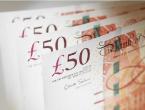Watching the foreign exchange market on October 11: technical analysis of the euro, the British pound and the Australian dollar
Currency: EUR/USD
Resistance 2: 1.1640
Resistance 1: 1.1580
Spot price: 1.1577
Support 1: 1.1500
Support 2: 1.144
The economic data last week was frequent, and the US non-agricultural employment data released last Friday became the peak. The US non-agricultural market is quite disappointed because the US only increased by 194,000 in September, which is far below the expected value of 500,000. The unemployment rate shrank to 4.8%, but the reason was that the employment participation rate shrank to 61.6%. Following this news, the U.S. dollar faced selling pressure, but the euro did not strengthen due to the overall weakness of the U.S. dollar. Because the German economic data disappointed the market even more, most of the German data fell short of market expectations. The monthly rate of factory orders in Germany recorded -7.7% in August, while industrial production fell 4% in August. In addition, Germany's trade account recorded a surplus of 13 billion euros, and exports fell by 1.2%. For this reason, the euro/dollar fell to a new low of 1.1528 in 2021. The weekly chart shows that the euro/dollar has fallen for five consecutive weeks. The EUR/USD is struggling near the 200 SMA and trading below the 100 SMA. At the same time, the 20 SMA maintains a strong bearish tendency and is far above the current price. At the same time, the technical indicators are still in the negative zone, finishing the decline, near the September low. The daily chart shows that the euro/dollar still maintains a bearish tendency. The EUR/USD is far below the bearish moving average, technical indicators are still in the negative zone, and the direction is unknown, indicating a lack of buying interest. If the EUR/USD drops below 1.1528, the year's low, it will test the 1.1460/70 area, which is a long-term resistance and a potential bearish target. If the EUR/USD drops below this level, it will test the 1.1390 area. If the EUR/USD breaks through 1.1640, it may rebound further, but when it approaches the 1.1700 mark, it may again incur selling interest.
Currency: GBP/USD
Resistance 2: 1.3773
Resistance 1: 1.3717
Spot price: 1.3641
Support 1: 1.3574
Support 2: 1.3525
On October 8th, affected by the mixed employment data in the United States, the pound against the dollar once hit a high for more than a week, but now it has almost given up all the gains. The bad non-agricultural data seems to have failed to cool the Fed's expectations of reducing debt purchases. The number of new jobs created in the United States in September was lower than expected for the second consecutive month, indicating a weak recovery in the labor market, complicating the Fed's decision to start reducing monetary support before the end of the year. Nevertheless, as companies raise wages, the reopening of schools and the end of federal unemployment benefits should lead to an increase in hiring in the coming months. Therefore, this month's non-agricultural data has hardly weakened expectations that the Fed will soon begin to reduce bond purchases and may raise interest rates in 2022. This was further reinforced by the subsequent counter-attack of the British pound shorts. In fact, the benchmark 10-year U.S. Treasury bond yield continues to stabilize at around 1.59%, which is close to a 4-month high. This, in turn, continued to boost the U.S. dollar and restrained any surge in the pound against the U.S. dollar. On the upside, the resistance levels focus on 1.3655, 1.3717, and 1.3743, and on the downside, the support levels focus on 1.3574, 1.3544, and 1.3500.
Currency: AUD/USD
Resistance level 2: 0.7400
Resistance 1: 0.7330
Spot price: 0.7316
Support 1: 0.7266
Support 2: 0.7200
The AUD/USD opened weak last week and fell to a low of 0.7225, but as market sentiment recovered, the AUD/USD closed above the 0.7300 mark. The Australian data released in recent days are quite encouraging and provide further support for the Australian dollar. The monthly rate of inflation of TD Securities rose by 0.3% in September, while the AIG Construction Industry Performance Index rose to 53.3 in September. The Commonwealth Banking Services Purchasing Managers Index in September recorded 45.5, better than the previous value of 44.9, but still in a contraction range. The AIG Service Industry Performance Index rose to 45.7. AUD/USD consolidates in the 38.2% Fibonacci and 50% Fibonacci 0.7477 and 0.7169 ranges of the recent daily decline. The next Fibonacci resistance of the AUD/USD is at 0.7360, and the AUD/USD needs to break through this level in order to rebound further. The daily chart shows that the AUD/USD maintains a moderately bullish stance, the AUD/USD is above the flat 20 moving average, while the long-term moving average maintains a bearish tendency and is above the current price. At the same time, the technical indicators are in a positive zone and have lost bullish momentum, but they have not shown a peak signal. If the AUD/USD breaks through 0.7360, it will first approach 0.7410 and then rise to the 0.7480 price area. However, the AUD/USD does not seem to show such a strong rebound. If the AUD/USD breaks below 0.7250, the shorts may regain the dominance and will then approach the annual low of 0.7105.
Only personal views, not representative of the views of the organization
Source: Bank of China's official website, Bank of China Guangdong Branch Wang Gang, original title: "Foreign Exchange Market Watch October 11, 2021"











